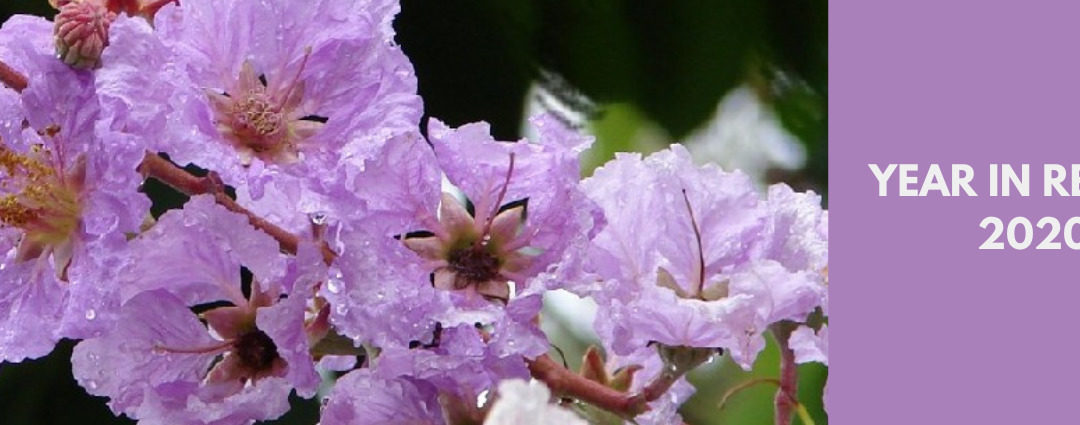Dear SeasonWatch supporter,
In this newsletter we bring to you some highlights from the year 2020. The COVID-19 pandemic affected all of us in various ways and surely taught us all to do things differently. At SeasonWatch, we couldn’t do some of the things we had done the year before, like organize events. We did some things differently, like have online workshops and talks instead of physical meetings, with one exception. And we tried some new things, like putting together a brand new website. Our main participants are school children and teachers, and the trees they watch are usually within their school campuses. Due to the pandemic, many of these trees couldn’t be watched regularly as before. Despite the challenges, our participants continued to contribute information and we are grateful for their determination, untiring spirit, and the love they have for their trees. Let’s take a look at the year it was.
Sincerely,
SeasonWatch team
OVERVIEW
A huge thanks to over 400 schools and colleges, and over 180 individuals who contributed their observations on trees in the year 2020, despite the pandemic. Due to our contributors, we now have over 4,00,000 (70,446 observations added in 2020) observations from nearly 91,000 trees (up from 79,065 in 2019) in our database. Nearly 87% (61,312) of the observations came from regularly observed trees and the remaining were one-time observations.
School students and teachers contributed 85% of all information, even as campuses remained closed and students were encouraged to observe trees near their homes. Kerala, as always contributed bulk of this information, 93% in 2020 as compared to the usual 80-85% in the previous years. Madhya Pradesh, Tamil Nadu, Karnataka and Meghalaya together contributed ~6% of the observations.
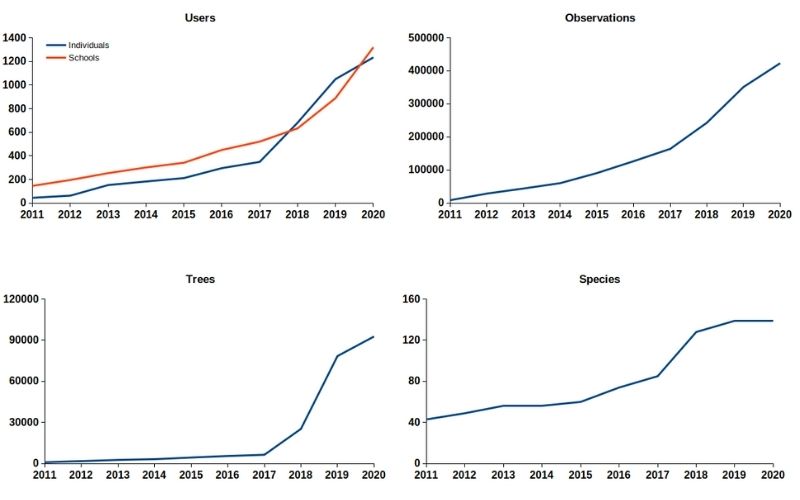
Clockwise, from top left: From 2011 to 2020, the number of users (category school and individual) that contributed at least one observation, number of observations, number of trees with at least one observation, and number of species having at least one observation. The big spike seen in 2019 was due to the bioblitz events that were organized in that year whereas the drop observed in 2020 is due to the COVID-19 pandemic.
The most commonly observed species were Mango Mangifera indica (2313), Jackfruit Artocarpus heterphyllus (1438), Teak Tectona grandis (803), Indian laburnum Cassia fistula (777), and Neem Azadirachta indica (498).
HIGHLIGHTS
TEACHERS AND COORDINATORS MEETING, 2020
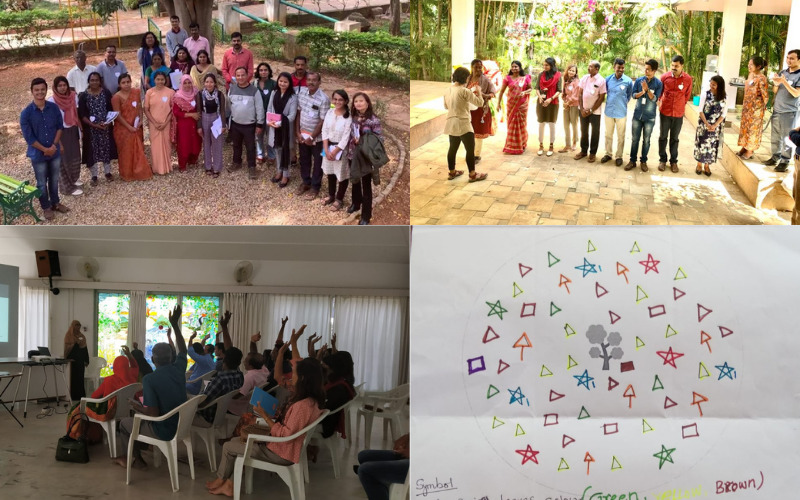
Clockwise, from top left: A group photo. Participant playing a game to understand data. Discussion and feedback on using the website and the app. An activity by a group marking a tree’s surrounding using different colours and symbols.
Before the pandemic started last year, we were fortunate to meet some of our teachers and coordinators, based in different parts of the country, in person for a meeting in Bangalore. This meeting brought some of our most enthusiastic contributors to meet one another in person, and share and learn from each other’s experiences. We used many hands-on activities and explored concepts of citizen science data, tree phenology, and nature education. Participants in the meeting explored the natural world in creative ways to rekindle their own interest and learned how to use some of these methods with their students.
TEA-TIME WITH TREES: A WEBINAR SERIES
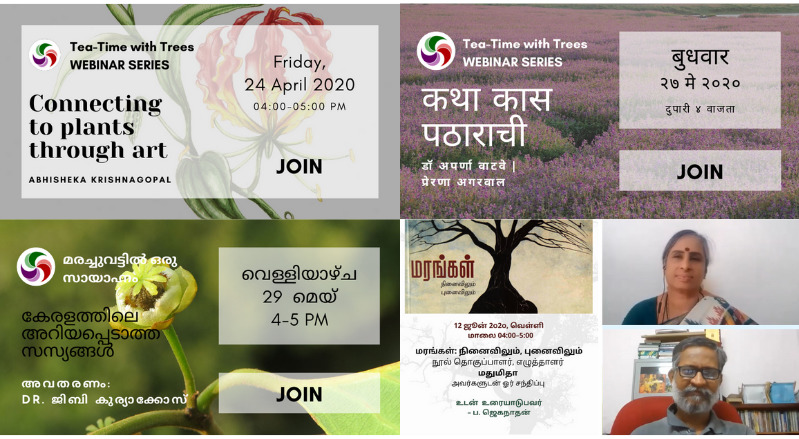
A selection of talks in the Tea-time with Trees webinar series
Once the pandemic started and the country went into lockdown, we too took our outreach and communication online, much like many others. We curated and streamed 11 public talks under the webinar series event Tea-time with trees, between April and June 2020. These talks were on plants and citizens – ranging from types, conservation, and restoration of habitats, to identifying plants using botanical characters and through art, to literature on plants and seasonality – in 4 different languages. All these talks are available on our YouTube channel.
TREE-WATCHING DURING THE PANDEMIC
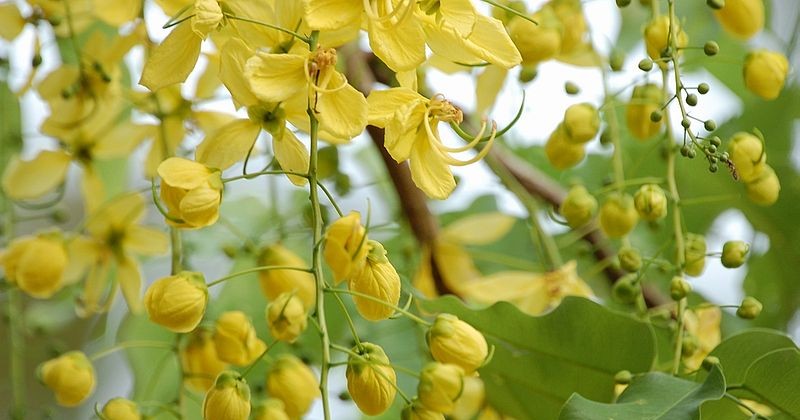
Indian Laburnum (Cassia fistula). Photo by Challiyan via Wikimedia Commons.
Though most schools remained closed for most of last year, some teachers found ways to watch trees. Here are a couple of experiences.
Ms Annamma T Baby, MTSSUP School, Manjadi, Thiruvalla
“My season watch group faced difficulties in monitoring our regular trees. As a result of the lockdown, I had to move to Konny, my native place which is 55 km away from Thiruvalla. Since, all my season watch trees were in Thiruvalla (some in the school campus and others on the way to the school), I felt very sad at the prospect of being so far away and at not being able to see them regularly. I felt that I lost everything. Finally one day, I thought of taking a risk and I hired an auto-rikshaw to go to Thriuvalla. I took the effort to observe all the trees. I notices that some of the trees appeared very gloomy as their leaves had turned yellowish. I couldn’t find any nests in the trees either. Some of the trees in my school campus had heaps of soil covering the ground portion. I spoke to some of my students and I was relieved to find that they too observed their trees from the terrace of their homes during the lockdown and tried their best to watch their trees. In the end I feel it has been a new and a wonderful experience!”
Mr Prabhakaran P V, GHSS Mathamangalam, Kannur
“Imposition of triple lockdown in my village in Kannur in the wake of COVID 19 didn’t prevent me from watching the trees or birds around my homestead. I have actively participated in the Lockdown Birding Challenge organised by Bird Count India. I could hear the songs of a lot birds which were collecting the nectar from Gulmohur and Teak trees at my homestead during the lockdown period. I have participated in the Season watch Home Photography Challenge 1& 2 and took the photos of trees and animals through my windows.
I could observe a lot of trees during my journey to the Centres for Higher Secondary Examination and Valuation which were held during the lockdown period. Selling of flowers of Indian laburnum (Cassia fistula) in the markets and shops on the eve of Vishu in April is a very big business in Kannur for the last few years. Because of the lockdown this year, flowers on these trees near the roadsides could be seen even after the Vishu. So more fruits are expected from laburnum trees this year. I have also observed the mangrove trees in my village and prepared a mangrove nursery for the free distribution of propagules and saplings to the members of SEED as part of the Mangrove Afforestation Program.”
OTHER TALKS AND WORKSHOPS
- Seasons of change: science and learning through observation. September 2020. Watch this plenary talk here.
- How to design your own Citizen Science project. September 2020. A workshop for the Wipro Earthian Sustainability Education partners.
- Fabulous photosynthesisers. July 2020. Watch this talk here.
- Tracking climate change through trees. November 2020. Watch this talk here.
A NEW WEBSITE
As SeasonWatch turned ten years old in 2020, our website got a brand new look with several new features. The user dashborad on SeasonWatch has Regular and Casual observations appearing side-by-side. Users now have a profile page to upload details about themselves. Profiles can be made public on the website so other users can keep track of your observations. Users can now edit, delete or share their observations on social media. Read in detail about this here.
FIRST DATA SUMMARY IN A PRE-PRINT
In August 2020, we summarized data collected in SeasonWatch between 2011 and 2019 in a scientific manuscript. It is currently available as a pre-print in BioRxiv and has been submitted to the Indian Academy of Science open-access journal Current Science for review. The paper can be accessed here.
Banner image credit: Giant Crepe Myrtle (Lagerstroemia speciosa). Photo by Tatiana Gerus via Wikimedia Commons

